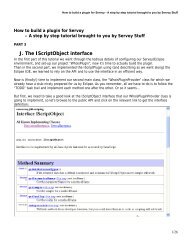Step by step tutorial: how to build a bean for Servoy - Servoy Stuff
Step by step tutorial: how to build a bean for Servoy - Servoy Stuff
Step by step tutorial: how to build a bean for Servoy - Servoy Stuff
You also want an ePaper? Increase the reach of your titles
YUMPU automatically turns print PDFs into web optimized ePapers that Google loves.
How <strong>to</strong> <strong>build</strong> a <strong>bean</strong> <strong>for</strong> <strong>Servoy</strong> - A <strong>step</strong> <strong>by</strong> <strong>step</strong> <strong>tu<strong>to</strong>rial</strong> brought <strong>to</strong> you <strong>by</strong> <strong>Servoy</strong> <strong>Stuff</strong><br />
I hope that they will understand that and add a little bit more <strong>to</strong> the public API <strong>for</strong> people who want <strong>to</strong><br />
<strong>build</strong> web client components and are serious about it. Without some of these interfaces and classes, it<br />
is virtually impossible <strong>to</strong> do so, when I was under the impression (drawn from the IComponent<br />
javadocs, <strong>for</strong> example) that the goal of the public API was <strong>to</strong> give developers the ability <strong>to</strong> develop<br />
third party components <strong>for</strong> the plat<strong>for</strong>m. – Apparently Johan Compagner is not <strong>to</strong>tally against the idea,<br />
so that’s good news!<br />
After these two components added, we add a fixed attribute <strong>to</strong> our markup, using<br />
add(new SimpleAttributeModifier("class", getId()+" field"));<br />
This sets a “class” attribute <strong>to</strong> our enclosing tag and set its value <strong>to</strong> the ID of our component +<br />
the key attribute “field” which is given <strong>to</strong> all input fields in <strong>Servoy</strong> (this allow <strong>for</strong> the CSS styling of all<br />
fields).<br />
And then of course we have the code <strong>to</strong> create our TextField and add it <strong>to</strong> our component.<br />
This is it <strong>for</strong> the code of our construc<strong>to</strong>r (we will add one last thing later but <strong>for</strong> now that’s enough).<br />
The second construc<strong>to</strong>r:<br />
public WicketTestBean(String id, IModel model) {<br />
which takes an ID and a Model is not really needed in our case since the model is taken from the “text”<br />
property of our class and not coming from another component, so we can get rid of it.<br />
W. Implementing the Wicket <strong>bean</strong><br />
Now let’s look at our implementation. For all the getters we are fine, because we have a variable that<br />
holds their values and that’s all there is <strong>to</strong> it, but <strong>for</strong> the setters, we actually need <strong>to</strong> update our<br />
component’s markup <strong>to</strong>o!<br />
To do this, we need <strong>to</strong> use yet another “not really public” class, which we will use in great length, this<br />
is the ChangesRecorder class (com.servoy.j2db.server.headlessclient.dataui.ChangesRecorder).<br />
The ChangesRecorder class is supposed <strong>to</strong> be modified in the next version of <strong>Servoy</strong> (“Tano”, now<br />
officially called 5.0 <strong>by</strong> Johan Compagner in its answer <strong>to</strong> my request ☺), and should be public <strong>by</strong> then<br />
so we will likely have <strong>to</strong> adapt our <strong>bean</strong>s but in the meantime, this class works as described here in<br />
4.1+…<br />
And <strong>to</strong> better use this class we will actually add it as a property <strong>to</strong> our class, like this:<br />
public ChangesRecorder jsChangeRecorder =<br />
new ChangesRecorder(new Insets(2,2,2,2), new Insets(0,0,0,0));<br />
Now the ChangesRecorder class is the one that will hold all the style changes <strong>for</strong> our component and<br />
that will tell Wicket <strong>to</strong> update its markup accordingly. We pass it 2 Insets (java.awt.Insets) which<br />
defines the default border and padding <strong>for</strong> our component.<br />
Once we have defined our ChangesRecorder inside a variable jsChangeRecorder, we will now use it in<br />
our setters, like so:<br />
public void setSize(Dimension size) {<br />
this.size = size;<br />
if (this.size != null) {<br />
jsChangeRecorder.setSize(size.width, size.height, this.border, null, 0);<br />
}<br />
}<br />
18/37



